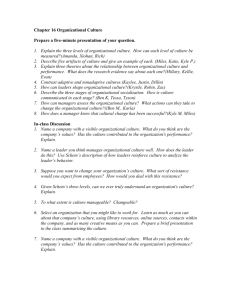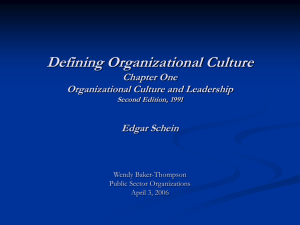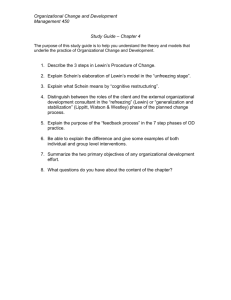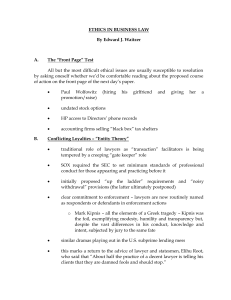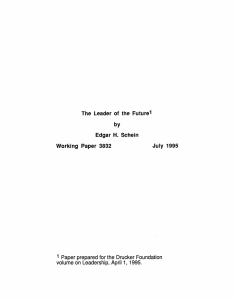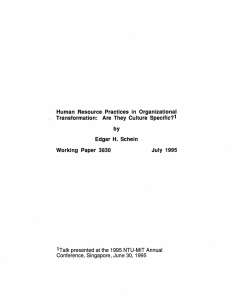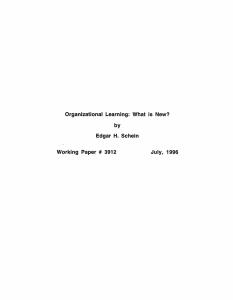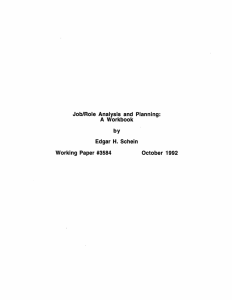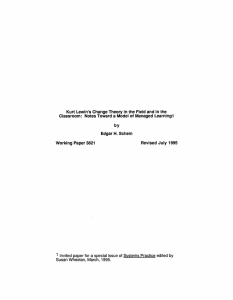INCREASING ORGANIZATIONAL EFFECTIVENESS THROUGH BETTER HUMAN RESOURCES PLANNING AND DEVELOPMENT Edgar H. Schein
advertisement
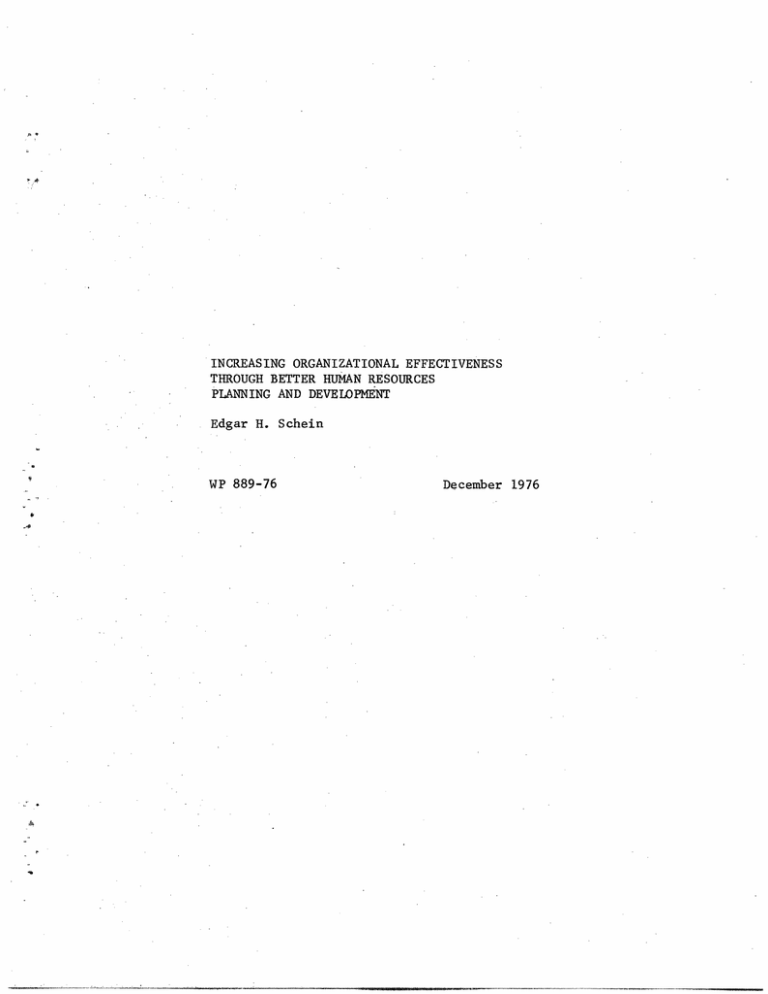
INCREASING ORGANIZATIONAL EFFECTIVENESS THROUGH BETTER HUMAN RESOURCES PLANNING AND DEVELOPMENT Edgar H. Schein WP 889-76 *--------- -----1^--11·----·----------_1_-- December 1976 Increasing Organizational Effectiveness Through Better Human Resource Planning and Development Edgar H. Schein Organization Studies Group, Sloan School of Managemengt, MIT November, 1976 Introduction In this paper I would like to address two basic questions. First, why is human resource planning and development becoming increasingly important as a determinant of organizational effectiveness? Second, what are the major components of a human resource planning and career development system, and how should these components be linked for maximum organizational effectiveness. The following observations and analyses are based on two kinds of research First, formal research which we have been doing at MIT for over 20 years on management development, how managerial careers evolve,and how individuals learn and grow. Second, several decades of involvement with organizations of all sorts and sizes attempting to help them to plan and implement human resource development programs and organization development activities. 1 (Footnotes at end) I. Why is human resource planning and development increasingly important? The first answer to this question is simple, though paradoxical. Or- ganizations are becoming more dependent upon people because they are increasingly involved in more complex technologies and are attempting to function in more complex economic, political, and socio-cultural environments. The more different technical skills there are involved in the design, manufacture, marketing, and sales of a product, the more vulnerable the organization will be to critical shortages of the right kinds of human resources. The more complex the process, the higher the inter-dependence among the various specialists. The higher the inter- dependence, the greater the need for effective integration of all the specialities _____1_11_1__·___II__1IE---·------- -2because the entire process is only as strong as its weakest link. In simpler technologies, managers could often compensate for the technical or communication failures,)of their subordinates. General managers today are much more dependent upon their technically trained subordinates because they usually do not understand the details of the engineering, marketing, financial, and other decisions which their subordinates are making. Even the general manager who grew up in finance may find that since his day the field of finance has outrun him and his subordinates are using models and methods that he cannot entirely understand. What all this means for the general manager is that he cannot any longer safely make decisions by himself; he cannot get enough information digested within his own head to be the integrator and decision maker. Instead, he finds himself increasingly having to manage the process of decision making, bringing the right people together around the right questions or problems, stimulating open discussion, insuring that all relevant information surfaces and is critically assessed, managing the emotional ups and downs of his prima donnas, facing and resolving conflicts among strong technical professionals, and insuring that out of all this human and interpersonal process, a good decision will result. As I have watched processes like these in management groups, I am struck by the fact that the decision emerges out of the interplay. It is hard to pin down who had the idea and who made the decision. The general manager in this setting is accountable for the decision, but rarely would I describe the process as one where he or she actually makes the decision, except in the sense of recognizing when the right answer has been achieved and ratifying that answer.. If the managerial job is increasingly moving in the direction I have indicated, managers of the future will have to be much more skilled in __________1_118_____ ___1_11· ______1__ ___ -3- 1) the selection and training of their subordinates, 2) how to design and run meetings and groups of all sorts, 3) how to deal with all kinds of conflict between strong individuals and groups, 4) how to influence and negotiate from a low power base, and, most importantly, 5) how to integrate the efforts of very diverse technical specialists. If the above image of what is happening to organizations has any generality, it will force the field of human resource management increasingly to center stage. The more complex organizations become, the more they will be vulnerable to human error. They will not necessarily employ more people, but they will employ more sophisticated highly trained people both in managerial and in individual contributor, staff roles. The price of low motivation, turnover, poor productivity, sabotage, and intra-organizational conflict will be higher in such an organization. Therefore it will become a matter of economic necessity to improve human resource planning and development systems. A second reason why human resource planning and development will become more central and important is that changing social values regarding the role of work will make it potentially more complicated to manage people. There are several kinds of research findings and observations which illustrate this point. First, my own longitudinal research of a panel of Sloan School graduates of the 1960's strongly suggests that we have put much too much emphasis on the traditional success syndrome of "climbing the corporate ladder." Some alumni indeed want to rise to high level general manager positions, but many others want to exercise their particular technical or functional competence and · only rise to levels of functional management or senior staff roles'with minimal --^11111·--1_ -4- managerial responsibility. Some want security, others are seeking non- organizational careers as teachers or consultants, while a few are becoming entrepreneurs. I have called these patterns of motivation, talent, and values "career anchors" and believe that they serve to stabilize and constrain the the career in predictible ways. The implication is obvious--Organizations must develop multiple reward systems to deal with different types of people. 2 Second, studies of young people entering organizations in the last couple of decades suggest that work and career are not as central a life pre-occupation as was once the case. Perhaps because of a prolonged period of economic affluence, people see more options for themselves and are increasingly exercising those options. Especially one sees more concern with a balanced life in which work, family, and self-development play a more equal role. 3 Third, closely linked to the above trend is the increase in the number of of women in organizations, which will have. its major impact of dual career families. through the increase As opportunities for women open up, we will see more new life-styles in young couples which will affect the organization's options as to moving people geographically, joint employment, joint career management, family support, etc.4 Fourth, research evidence is beginning to accumulate that personal growth and development is a life-long process and that predictable issues and crises come up in every decade of our lives. Organizations will have to be much more aware of what these issues are, how work and family interact, and how to manage people at different ages. The current "hot button" is mid-career crisis, but the more research we do the more we find developmental crises at all ages and stages. 5 For all of these reasons human resource planning and development systems will have to become sophisticated and responsive. of such systems and examine their linkage. 11_1_1____11____I-·a··--I- Let us now look at the components -5- I.Colponents of a Human Resource Planning and Development System The major problem with existing human resource systems is that they are fragmented, incomplete, and sometimes built on faulty assumptions about human growth. Human growth takes place through succesive encounters with one's environment. As the person encounters a new situation, he or she is forced to try new responses to deal with that situation. Learning takes place as a function of how those responses work out, the results they achieve. If they are successful in coping with the situation, the person enlarges his repertory of responses; if they are not successful the person must try alternate responses until the situation has been dealt with. If none of the active coping responses work, the person sometimes falls back on retreating from the new situation, or denying that there is a problem to be solved. responses are defensive and growth limiting. These The implication is that for growth to occur the person needs two things: 1) new challenges that are within the range of his coping responses, and 2) knowledge of results, information on how his or her responses to the challenge have worked out. If the tasks and challenges are too easy or too hard, the person will be demotivated and cease to grow. If the information is not available on how well the persons' responses are working, the person cannot grow in a systematic, valid direction but is forced into guessing or trying to infer information from ambiguous signals. How do the components of a human resource planning and development system relate to organizational needs or human growth needs? ... 1__11 -6- A.Organization Planning Components Al. Strategic, business planning-- the purpose is to determine the organization's future directions, products, markets, organizational forms, growth rate, geographical locations, etc. A2. Job/role planning--based on the strategic plan, what are the predictable consequences for managerial jobs, specialist roles and skill mixes which will be needed to get the mission accomplished; the focus here is on types of skills needed and how existing jobs will evolve and change? 6 A3."Manpower Planning&"--bsed on Al. and A2, how many people will be needed in each of the major categories of critical resources identified? Replacement planning for existing managerial jobs must be done to insure that functions will continue to be performed as people move up or out. These first three component activities are all geared to identifying the organization's needs in the human resource area. They are difficult to do and tools are only now beginning to be developed for Job/role planning. In most organizations I have dealt with, the three areas, if they exist at all, are not linked to each other organizationally. likely to exist in the Office of the President. Strategic planning is Job/role planning is likely to be an offshoot of some management development activities in Personnel. And Manpower planning is likely to be a specialized sub-section with- in Personnel. Typically, no-one is accountable for bringing these activities together even on an ad hoc basis. This situation reflects an erroneous assumption about growth and development which I want to mention at this time. The assumption is that if we develop our present human resources, they will be able to fill whatever job demands may arise in the future. Thus we do find in organizations elaborate human resource planning systems, but they plan for the present people in the organization, .^-· i ' . . L-----ir.^ll;;.-.l·-'·li_---P·l^-----· -7- If there are no major changes in job re- not for the organization per se. q.~irements as the organization grows and develops, this system will work. But if jobs themselves change, it is no longer safe to assume that today's' human resources, with development plans based on today's job requirements will produce the people needed in some future situation. Therefore, I am asserting that more job/role planning must be done, independent of the present people in the organization. B. Staffing and Job Assignment Components Bl. Recruitment and Selection--insuring that the right kinds of people are brought into the organization based on present and future needs. B2. Initial training and induction into the organization--one of the first challenges the new employee faces is making it into the organization and becoming a productive and useful member of it. Is the induction process handled in a manner which makes it possible for the employee to learn the right attitudes and skills for short-run and long-run contribution? Are the messages given here consistent with those given in B1? 7 ' B3. Job assignment and supervision--is the first job optimally challenging in terms of the capacities of the employee and the needs of the organization? If the job is too easy or too meaningless, the employee will become demotivated and/or leave which will meet neither the employee's nor the organization's need. If the job is too difficult the employee will become frustrated and angry. B4, Career development--the system of determining successive jobs whether these represent promotion, lateral movement to new functions, or simply new assignments within a given area. In most organizations there is no system here but an ad hoc process of moving people as jobs open up. These four components are geared to insuring that the work of the organization _...-.·--_I i------ ___ )__I^_I*^-^III^--I --·-·--·---L--------- -8- e ~ will be performed. They tend to involve primarily "line management" though in many organizations the recruitment, selection, and initial training are centrally handled by Personnel. Indeed, one of the problems which one can identify in early careers of managers is that the recruitment/selection process is not well enough linked to the job assignment and supervisory process. The result is often disappointment, unmet expectations, reality shocks of various kinds, and high turnover or low productivity. C. Performance Appraisal and Judgment of Potential Components Cl. Performance appraisal for salary action--most human resource systems have some procedure for determining how much of a salary increase to give and whether or not to consider bonuses or other special rewards. Typically the employee's supervisor makes a formal or informal rating or ranking which be- comes the basis of subsequent actions. C2. Judgment of potential--many systems ask the supervisor to identify high potential employees and to make some estimate of how high they can go in the organization; it is in relation to this judgment that the supervisor is also often asked to provide some estimate of "strengths," weaknesses," and "development needs". Depending on how organized the above activities are,all of the information about employees, especially high potential employees is collected and filed within the personnel department so that it is available to the training and management development functions. In some organizations the system gen- erates proposals for specific development activities for specific high potential individuals. If common needs are identified for many employees, the information can become the source of an in-house training program. the linkage between performance appraisal, In other words, potential appraisal, and management development as defined by in-house development activities is often quite tight __1_1____ _I I· __·_______1_1___^_______ ___ _ -9- and effective, creating the illusion that the program overall will produce what the organization needs. However, there are two things which often go wrong--one, the individual does not get feedback and therefore does not get involved in his own development; and, two, the development plans for people are not linked to the needs of the organization as defined in the organizational planning activities. Most systems pay lip-service to feedback, encourage supervisors to give it, and even run training programs on giving feedback, but the fact is that most supervisors find it uncomfortable and avoid it. In fact, in many systems the ratings of potential are concealed from the individual for fear that their revelation would cause false expectations or morale problems among peers. The difficulty is that unless the individual gets clear feedback he cannot undertake to develop himself. It is an erroneous assumption that the organization can develop people; it can only provide the opportunity and the feedback. Whether or not the individual develops is a function of what plans are inside him and how the opportunities mesh with what is desired by the person. The second problem of lack of linkage to organizational planning is equally damaging. If the individual is given no information on future pos- sibilities based on real planning, he cannot make a realistic development plan for himself. At the same time, the organization has no mechanism by which to insure that the talent it needs will be available. All of the above argues for the next components to be elevated from merely desirable adjuncts of performance appraisal to being conceived as necessary.central components of any human resource system. D. Provisions for knowledge of results, feedback, and career counseling components D1. Job assignments which have closure--whether we are talking about a __I_______ ______X_ IIIIIIII___II___I___________1_1111 _I___LI_________X_.___ -10- one month project or a two-year rotational assignment, it is important that someone consider the optimum length of time so that the individual in the job can learn from his own performance. Too often we move people too fast to fill.slots and thereby undermine their development. D2. Systematic performance feedback--if strengths and weaknesses are assessed, it is essential that the individual learn what those assessments are; without such information the individual cannot grow. If we set about to train people perhaps we should train them in how to get feedback. D3. Systematic dialogue about future potential, career options--the individual cannot manage his own growth and development without information on how his own needs, talents, values, and plans mesh with the opportunity structure of the organization; even-though the organization may only have imperfect, uncertain information about the future, the individual is better off to know that than to make erroneous assumptions future based on no information at all. about the It is true that the organization cannot make commitments, nor should it unless required to by legislation or contract. But the sharing of information if properly done is not the sansmas making commitments or setting up false expectations. If the organization can open up the communication channel between the individual, his boss, and who-ever is managing the human resource system, the groundwork is laid for realistic individual development planning. E. Joint development planning, execution, and follow-up components El. Joint career planning between employee and organization--Whatever is decided about training, next steps, special assignments, rotation, etc. should be jointly decided by the individual and the appropriate organizational ·_ ___I_ I_________s_·_saQ______l___s_____^___ -11- resource (probably the supervisor and someone from personnel specializing in career development). Each step must fit into and must be tied into organizational needs. the employee's life plan The organization should be neither a humanistic charity nor an indoctrination center. Instead, it should be a vehicle for meeting both the needs of society and of individuals. E2. Whatever is decided should not merely be written down but executed. If there are implementation problems the development plan should be renegotiated. E3. Follow-up and evaluation--whatever developmental actions are taken it is essential that they be followed up and evaluated both by the person and by It is shocking the organization to determine what, if anything, was achieved. to discover how many companies invest in major activities such as University executive development programs and never determine for themselves what was accomplished. In some instances, they make no plans to talk to the individual before or after the program so that it is not even possible to determine what the activity meant to the participant, or what might be an appropriate next assignment for him/her following the program. I can summarize the above analysis best by emphasizing the two places where I feel there is the most fragmentation and violation of growth assumptions. First, too many of the activities occur without the involvement of the person who is "being developed" and therefore may well end up being self-defeating. This is particularly true of job assignments and performance appraisal where too little involvement and eedback occurs. Second, too much of the human resource system functions as a personnel selection system unconnected to either the needs of the organization or the needs of the individual. All too often it is only a system for short-run replacement of people in standard type jobs. The key lanning functions are not linked in solidly and hence ·do not influence the system to the degree they should. _··_II_____ ____ ____ __ ___l_____s_ll____ll_11_1______ _ -12- If organizations begin to listen more closely to the needs and concerns of their employees at all levels, they will begin to have the raw data with which to develop some further important innovations around conditions of work, the reward system, flexible benefits, multiple career ladders, sabbaticals, flexible working hours, trial visits prior to geographical moves, part-time work, family support program, and so on. But none of those innovations should be attempted without first clearly establishing a human resource planning system which takes care of the organization's needs as well as the needs of employees and linking them to each other. There can be little growth and development for employees in an organization which is sick and stagnant. It is in the best interests of both the individual and the organization to have a healthy organization which can provide opportunities for growth. A concluding remark on the role of line management I hope it is clear from what has been said above that an effective human resource planning and development system is integral to the functioning of the organization Many of the must rest and must, therefore, be a central concern of line management. activities require specialist help, but the accountabilities squarely on line supervisors. and the rewards. It is they who control the opportunities It is the job assignment system and the feedback which employees get which is the raw material for growth and development. Whoever designs the system, it will not help the organization to become more effective unless it is owned by line management. ii Footnotes 1. A sample of the work which has come out of these decades of research is McGregor, D. The human side of enterprise. (N.Y. McGraw-Hill, 1960); Bennis, W.G. Changing organizations. (N.Y. McGraw-Hill, 1966); Schein, E.H. Organizational psychology, (Englewood Cliffs, NJ consultation. (Reading, Mass. Prentice-Hall, 1965) and Process Addison-Wesley, 1969); and Beckhard, R. Organization development. (Reading, Mass. Addison-Wesley, 1969), as well as the rest of the Addison-Wesley series of organization development edited by Schein, Backhard and Bennis. 2. The basic panel research leading to this concept is reported in E.H. Schein "How career anchors hold executives to their paths." Personnel, May-June, 1975, pp. 11-24. 3. See Bailyn, L. & Schein, E.H. of quality of employment. Life/career considerations as indicators In Biderman, A.D. and Drury, T.F. (eds.). Measuring Work Quality for Social Reporting, NY: Sage, 1976. 4. See Van Maanen, J. and Schein, E.H. Improving the quality of work life: career development. Life. In Hackman, R. (ed.) Improving the Quality of Work Los Angeles: Goodyear, 1976. 5. An excellent review of this whole area can be found in Gail Sheehy's recent book, Passages. 6. See Schein, E.H. NY: Dutton, 1976. How to break in the college graduate. Business Review, 1964, 42, pp.68-76. ---lc--- --· ·-----------"" ·------ Harvard
